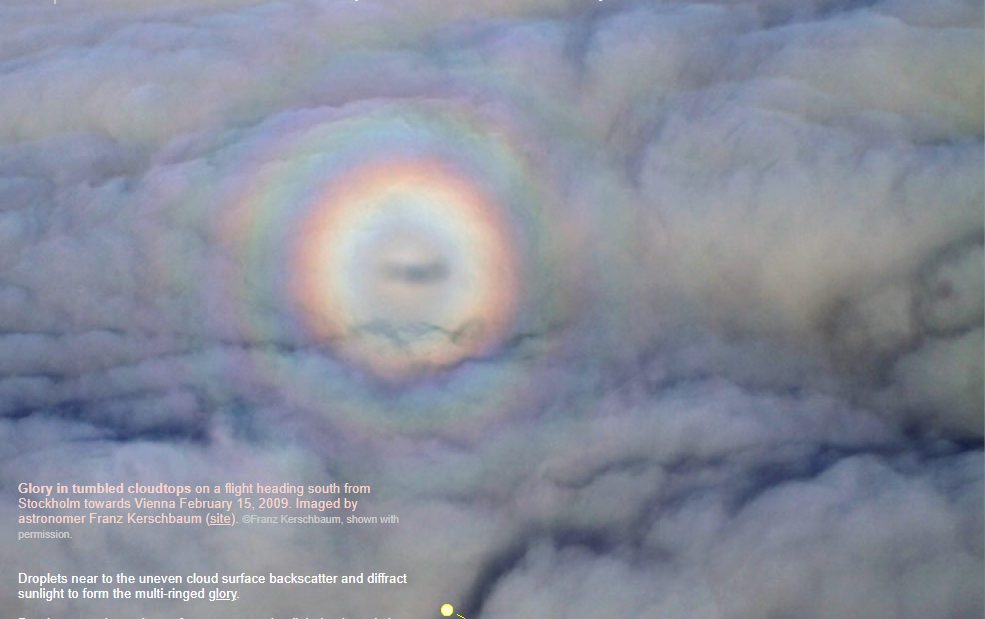Constant Optics
Constant Optics: Understanding the Phenomenon of Glories, Halos, and Rainbows
Have you ever marveled at the sight of a multi-ringed glory or a vibrant rainbow in the sky? These optical phenomena, known as glories, halos, and rainbows, have captivated human imagination for centuries. In this article, we will explore the concept of "constant optics," which refers to the consistent angular size and appearance of these atmospheric wonders, regardless of the distances or sizes of the particles involved.
Glories, like the one captured in the image above, are formed when sunlight interacts with tiny water droplets near the surface of clouds. As sunlight passes through these droplets, it undergoes scattering, diffraction, and backscattering processes. The scattered light is then observed by an observer positioned in a specific location relative to the sun and the cloud.
Despite the uneven distribution and varying distances of the cloud droplets, glories often exhibit remarkable circular and concentric ring patterns. This uniformity suggests that the droplets within the observer's field of view are approximately the same size. However, it is worth noting that glories can deviate from circular shapes when the droplets differ in size across the field of view.
One fascinating aspect of glories is their independence from cloud distance. Regardless of whether the droplets are near or far from the observer, the glory will always maintain the same angular size and appearance. This constancy is a result of the similar scattering and diffraction processes occurring in the droplets, irrespective of their proximity to the observer.
To further illustrate this point, let's consider a scenario where there are two clouds at different heights. The droplets in the top cloud contribute to a red glory ring and are located on a small ellipse due to the angle at which sunlight interacts with the cloud surface. On the other hand, the droplets forming the same ring in the lower cloud are situated on a larger ellipse. Despite the difference in ellipses, the glory appears circular to the human eye because both ellipses subtend the same angle, giving the illusion of equal size.
The concept of constant optics extends beyond glories and applies to other atmospheric optical phenomena like halos and rainbows. Halos, which are formed by the interaction of sunlight with ice crystals in the atmosphere, exhibit a consistent angular size regardless of the distances or sizes of the crystals involved. Similarly, rainbows, created by the refraction and reflection of sunlight in water droplets, maintain their characteristic appearance regardless of the distances between the observer and the raindrops.
Understanding constant optics allows us to appreciate the underlying principles governing these atmospheric optical phenomena. By recognizing that the angular size and appearance of glories, halos, and rainbows remain constant regardless of distance or size, we can better interpret and appreciate the beauty of these natural spectacles.
In conclusion, constant optics refers to the consistent angular size and appearance of glories, halos, and rainbows, irrespective of the distances or sizes of the particles involved. Glories, in particular, exhibit circular and concentric ring patterns due to similar-sized droplets within the observer's field of view. The concept of constant optics applies to other atmospheric optical phenomena as well, such as halos and rainbows. By understanding these principles, we can deepen our appreciation for the awe-inspiring beauty of these natural wonders that grace our skies.

Glory in tumbled cloudtops on a flight heading south from
Stockholm towards Vienna February 15, 2009. Imaged by
astronomer Franz Kerschbaum (site). ©Franz Kerschbaum, shown with permission.
Droplets near to the uneven cloud surface backscatter and diffract sunlight to form the multi-ringed glory.
Droplets over the entire surface are scattering light backwards but only light from those close to a line from the sun, through the airplane to the clouds reaches the eye or camera to form one's personal glory.
Despite the very uneven clouds and their different distances, the glory rings remain more or less circular and concentric. This tells us that the droplets in the field of view are of similar size. Glories can be non circular when the droplets making them vary in size across the field of view.
Provided that the droplets are the same size it does not matter how far away or near are the clouds. The glory will always have the same angular size and appear the same.
Droplets in the top cloud (diagram at right) contributing light to a red glory ring are located on a small ellipse. An ellipse because the cloud surface is not perpendicular to the direction of the sun's rays. Droplets forming the ring but farther away in the lower cloud are on a larger ellipse. But to the eye both ellipses subtend exactly the same angle, they appear to be the same size - AND the glory looks circular!
Halos and rainbows behave the same way. They keep the same angular size regardless of the distances of their crystals or raindrops. They do not have physical dimensions or distances.

Note: this article has been automatically converted from the old site and may not appear as intended. You can find the original article here.
Reference Atmospheric Optics
If you use any of the definitions, information, or data presented on Atmospheric Optics, please copy the link or reference below to properly credit us as the reference source. Thank you!
-
<a href="https://atoptics.co.uk/blog/constant-optics/">Constant Optics</a>
-
"Constant Optics". Atmospheric Optics. Accessed on November 26, 2024. https://atoptics.co.uk/blog/constant-optics/.
-
"Constant Optics". Atmospheric Optics, https://atoptics.co.uk/blog/constant-optics/. Accessed 26 November, 2024
-
Constant Optics. Atmospheric Optics. Retrieved from https://atoptics.co.uk/blog/constant-optics/.